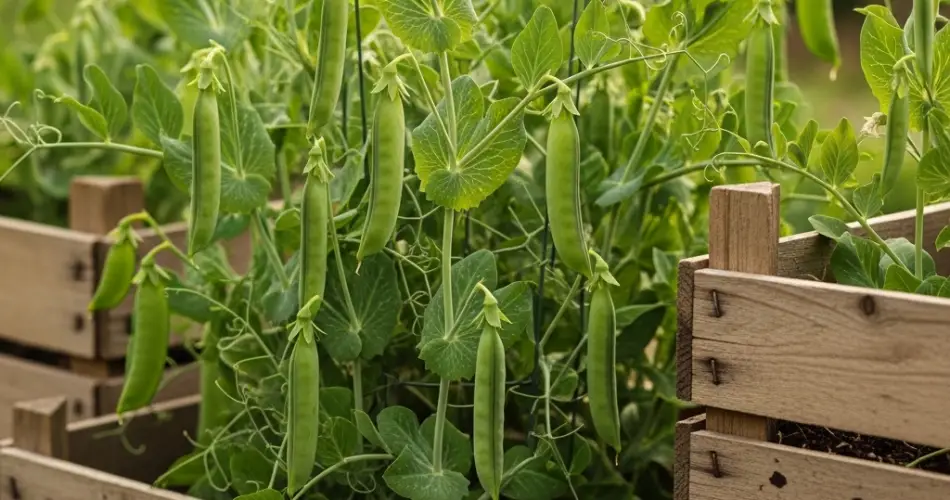Peas are a delicious and nutritious addition to any garden—and the good news is, you don’t need a large yard to grow them. With a few simple wooden crates, you can cultivate an abundant pea harvest even in compact spaces. Crate gardening is ideal for balconies, patios, and small backyard areas where traditional soil beds aren’t an option. It’s space-saving, customizable, and surprisingly productive.
Whether you’re growing snow peas, sugar snap peas, or shelling peas, using crates can simplify the process while still delivering a bountiful yield. Here’s how to grow peas in crates and make the most of your limited space.
Why Choose Crates for Peas?
Pea plants thrive in cool weather and perform well in containers, making crates an ideal growing option. Crates allow you to control soil quality, manage drainage, and position your plants in the sunniest spots. They’re easy to move and perfect for urban gardening, where space and access to soil may be limited.
Because peas grow upward rather than outward, they don’t take up much ground area. All they need is a bit of vertical support, which crates can easily accommodate with the addition of a trellis or simple frame.
Selecting the Right Crate
Start with a wooden crate that’s at least 12 inches deep and 12–18 inches wide. This gives the roots enough space to develop while allowing room for multiple plants.
Ensure your crate has drainage holes at the bottom. If it doesn’t, drill a few yourself. To protect the wood and retain soil, line the inside with breathable fabric such as burlap or landscape cloth.
You can elevate the crate slightly with bricks or blocks to improve airflow and prevent wood rot from moisture buildup underneath.
Soil Mix and Preparation
Peas prefer well-drained, loose soil that’s rich in organic matter. For your crate bed, mix:
-
2 parts potting soil
-
1 part compost
-
A handful of perlite or coarse sand for added drainage
Peas don’t need heavy feeding because they fix their own nitrogen. However, incorporating compost or a small amount of balanced fertilizer at planting time can help with early growth.
Before planting, fill the crate with your prepared soil mix, leaving about an inch of space at the top to avoid spillage when watering.
Choosing Pea Varieties
There are several types of peas suitable for crate gardening:
-
Snow Peas – Grown for their flat, edible pods.
-
Sugar Snap Peas – Crisp and sweet, both pod and peas are edible.
-
Shelling Peas (Garden Peas) – Grown for the peas inside the pod, which must be shelled before eating.
For compact crates, dwarf or bush varieties are ideal. If you have vertical space, vining types will work well with a trellis or bamboo support.
Planting Peas in Crates
Peas grow best when directly sown into the soil. In cool climates, plant seeds as early as possible in spring, about 4–6 weeks before the last frost date. In mild climates, fall planting is also an option.
-
Sow seeds 1 inch deep and 2 inches apart in rows.
-
If using a trellis, plant seeds near the base to allow them to climb naturally.
-
Water gently after planting and keep the soil evenly moist.
Seedlings will emerge in 7–14 days depending on temperature.
Support Structures
Vining pea varieties need something to climb on. Install your support at the time of planting to avoid disturbing roots later. Options include:
-
A-frame trellises
-
Vertical netting
-
Bamboo stakes with twine
-
Wire cages
Even small bush varieties benefit from light support to prevent them from falling over as they grow.
Watering and Care
-
Watering: Peas like consistent moisture but dislike soggy roots. Water deeply once or twice a week, depending on weather.
-
Mulching: Add a thin layer of straw or dried leaves to retain moisture and suppress weeds.
-
Sunlight: Ensure your crate receives 6–8 hours of sunlight daily.
Once the plants begin flowering, water regularly to help pods form. Avoid overhead watering to reduce the risk of fungal issues.
Common Pests and Problems
Keep an eye out for:
-
Aphids – Spray off with water or use neem oil.
-
Powdery Mildew – Ensure proper spacing and air circulation.
-
Birds – Cover seedlings with mesh if birds are snacking on young plants.
Healthy plants grown in quality soil are more resistant to pests and diseases, especially in well-maintained crates.
Harvesting Peas
Harvest time depends on the variety:
-
Snow peas: Pick when pods are flat but full-sized.
-
Sugar snap peas: Harvest when pods are plump and crisp.
-
Shelling peas: Wait until pods are full, but before they start to yellow.
Use scissors or pinch pods gently to avoid damaging the plant. Frequent harvesting encourages more pod production.
Final Tips
-
Rotate your crops each season if reusing soil. Peas enrich the soil with nitrogen, so they’re great before planting leafy greens.
-
After the season, compost old vines or turn them into the soil as green manure.
-
Try interplanting peas with herbs or radishes to maximize your crate garden’s productivity.
Conclusion
Growing peas in crates is a smart, space-saving solution for anyone who wants to enjoy fresh produce without a traditional garden plot. With just a little effort and a few basic materials, you can create a productive vertical garden that adds both flavor and charm to your outdoor space. Whether you’re working with a backyard corner or a sunny balcony, crate gardening brings the joy of homegrown peas within easy reach.



